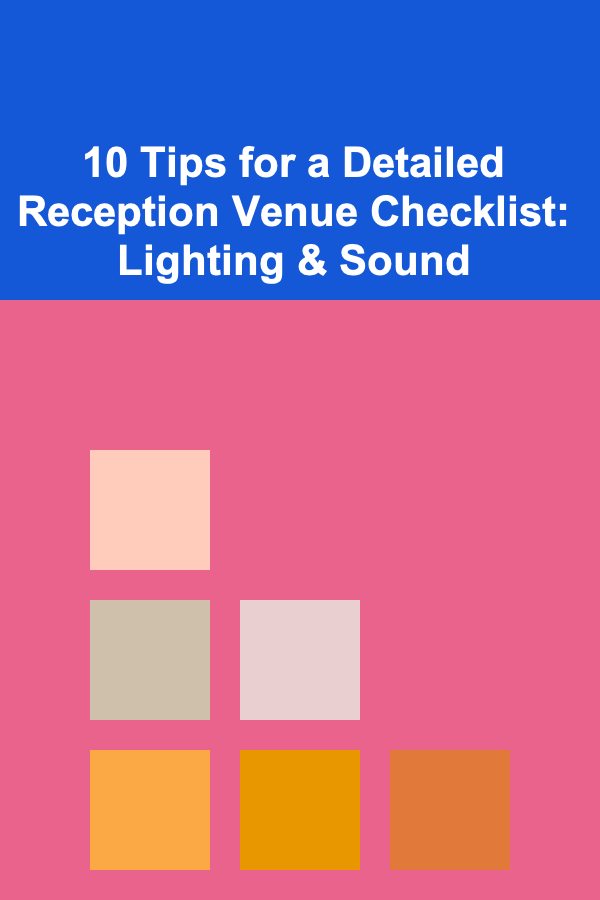
10 Tips for a Detailed Reception Venue Checklist: Lighting & Sound
ebook include PDF & Audio bundle (Micro Guide)
$12.99$11.99
Limited Time Offer! Order within the next:

When it comes to hosting a successful event, especially a reception, the atmosphere is everything. Two of the most crucial factors in creating the perfect ambiance are lighting and sound. Whether you are organizing a wedding reception, a corporate event, or a special celebration, these elements are fundamental in ensuring your guests have an unforgettable experience.
A well-thought-out lighting and sound setup will not only enhance the mood but also contribute to the overall flow and energy of the event. In this article, we will discuss 10 essential tips to help you create a detailed reception venue checklist, focusing on the critical aspects of lighting and sound.
Understand the Event's Theme and Atmosphere
Before diving into the specifics of lighting and sound, it's essential to understand the theme and mood you want to create for your event. Whether it's a formal, romantic, or casual gathering, the lighting and sound should align with the overall atmosphere.
Key Considerations:
- Romantic or intimate events: Opt for soft, warm lighting with minimal shadows. Think about candles, chandeliers, or uplighting.
- Casual or fun events: Bright, vibrant lighting combined with upbeat, lively sound works well here.
- Corporate or formal events: Clean, bright lighting with more subdued, professional sound setups will be appropriate.
Once you determine the mood, you can customize your lighting and sound equipment to fit.
Assess the Venue's Lighting Options
Most venues come with built-in lighting, but it's important to assess how well these existing systems will suit your event. Check if the lighting is adjustable, and if so, how versatile it is for creating different moods throughout the evening.
Things to Check:
- Brightness: Ensure that the lighting is adequate for the size of the venue. The last thing you want is for the room to be either too dark or blindingly bright.
- Color options: Some venues offer customizable lighting with RGB or color-changing LEDs. This can be a great feature if you want to create a dramatic effect or emphasize particular areas of the venue.
- Ambient vs. task lighting: Make sure there's enough ambient lighting for guests to move around comfortably but also be aware of task lighting for specific activities like speeches or dancing.
If the venue's lighting doesn't fit your needs, consider hiring a lighting designer or renting additional lights.
Add Accent Lighting to Key Areas
In a large reception hall or outdoor setting, it's essential to highlight certain areas to guide the flow of the event. Accent lighting can draw attention to focal points such as the stage, guest seating, food stations, or decor.
Tips for Accent Lighting:
- Highlight the entrance: Welcoming guests with a well-lit entrance sets the tone for the event. Consider using a spotlight or creating a path with lighting fixtures.
- Focus on the stage: If you have a stage for speeches, entertainment, or dancing, ensure it's brightly lit. Use spotlights to highlight key speakers or performers.
- Illuminate key decor: Use uplighting or gobo projectors to accentuate specific decorations, flowers, or architectural features in the venue.
Properly placed accent lighting will not only improve visibility but also elevate the aesthetics of your event.
Consider the Lighting Temperature
The temperature of the lighting---whether warm or cool---has a significant impact on the mood of your reception. Different lighting temperatures can make the environment feel more inviting or sterile, depending on your choice.
Guidelines for Lighting Temperature:
- Warm lighting: This type of light creates a cozy, welcoming, and intimate atmosphere, making it ideal for weddings, dinners, and other social gatherings. It's commonly used in the evening to simulate the golden hour.
- Cool lighting: Cooler lighting, such as blue or white light, can give a more professional, modern, and crisp look. It's often used in corporate or larger events.
Be mindful of how your lighting temperature aligns with the time of day and the event's purpose.
Choose the Right Sound System
A good sound system is essential for ensuring that your guests can hear speeches, announcements, and music clearly. When planning the audio setup, you must evaluate the acoustics of the venue and the type of sound required for different areas.
Things to Consider:
- Venue size and acoustics: Smaller venues typically don't require heavy sound equipment, while larger venues may need multiple speakers and amplifiers. Acoustic treatment may also be necessary if the venue has excessive echo.
- Microphones: Ensure that you have enough microphones for speakers, hosts, and performers. Wireless microphones provide greater mobility, while lapel microphones offer hands-free convenience.
- Sound mixing: Hire a professional sound technician to handle the mixing and ensure optimal sound levels. A balanced sound system will prevent distortion, feedback, or too-low volume levels.
A poor sound system can completely disrupt the event experience, so ensure everything is tested beforehand.
Use Music to Enhance the Mood
Music is a powerful tool for setting the tone of your reception. Whether it's background music, dance tracks, or ceremonial music, the right choice can deeply affect the atmosphere.
Music for Different Moments:
- Welcome & Reception: Use soothing instrumental or light jazz music to create a calm, welcoming environment as guests arrive.
- Dinner: Choose slower, ambient music to allow for conversation while keeping the energy relaxed.
- Dancing & Celebration: Upbeat music will energize your guests and encourage them to get on the dance floor. Consider creating a playlist that includes a mix of genres to appeal to different tastes.
Keep in mind that the volume of the music should allow guests to converse comfortably without shouting.
Test the Lighting and Sound in the Venue
Once you've selected your lighting and sound options, it's critical to test them out before the event begins. Walk through the entire venue, paying attention to how the lighting looks in different areas and whether the sound is clear and balanced.
Testing Tips:
- Lighting: Make sure there's adequate lighting in all areas of the venue, and check if the lights can be dimmed or adjusted throughout the event. If possible, test how the lighting interacts with decor and seating arrangements.
- Sound: Test the sound system in different parts of the venue to ensure that speakers are correctly positioned and sound levels are balanced. Walk around the venue and note any areas with poor sound quality or feedback.
Testing before the event ensures there are no surprises and helps you fine-tune the setup.
Incorporate Custom Lighting Effects
To create a memorable reception experience, consider incorporating custom lighting effects that align with your theme or event objectives. Gobo projectors, moving lights, or laser effects can add a unique touch and elevate the ambiance.
Creative Lighting Ideas:
- Gobo projections: These can project custom logos, monograms, or themed designs onto walls or floors. For example, projecting the couple's initials or wedding date at a wedding reception.
- Fairy lights: These create a whimsical, romantic atmosphere and are perfect for adding a soft glow to tables, chairs, or trees in outdoor venues.
- Moving lights: For a more dynamic environment, moving lights can be used to create exciting visual effects during dance performances or DJ sets.
Custom lighting effects should be used strategically to avoid overwhelming the venue's atmosphere.
Plan for Backup Sound and Lighting
While you may not want to think about things going wrong, it's essential to plan for contingencies. Have backup systems in place for both lighting and sound in case of failure.
Backup Suggestions:
- Backup lighting: Have a set of portable lights or candles ready in case the main lighting system fails.
- Backup sound: Bring along a secondary sound system or wireless microphones, especially if you're working in a large venue or outdoors.
Having backups on standby will help ensure that the event runs smoothly without any interruptions.
Work with Professionals
Although it's possible to rent equipment and attempt DIY setups for lighting and sound, hiring professionals is often the best choice. A lighting designer or sound engineer will have the expertise to ensure that both elements are optimized for your venue.
Why Hire Professionals:
- Expert knowledge: Professionals understand how to manipulate lighting and sound to create the best effects based on the venue and event type.
- Seamless execution: With a dedicated team handling the technical aspects, you can focus on enjoying your event without worrying about any glitches.
- Troubleshooting: Should any issues arise during the event, professionals are equipped to solve them quickly and efficiently.
Investing in professional lighting and sound services may cost more upfront but will ensure a flawless event.
Conclusion
Lighting and sound are two of the most influential factors in shaping the mood and success of a reception. By paying attention to every detail---from the right temperature of lighting to the appropriate sound system---you can create an environment that enhances the overall experience for your guests.
Use this checklist to help you create a thorough plan for your event's lighting and sound setup. With careful consideration, testing, and professional support, you can ensure that both elements work together harmoniously, creating the perfect ambiance for your reception.
Reading More From Our Other Websites
- [Skydiving Tip 101] How to Build a DIY Skydiving Logbook That Meets USPA Certification Standards
- [Home Holiday Decoration 101] How to Organize Holiday Decorations to Avoid Clutter
- [Hiking with Kids Tip 101] Family-Friendly Trails for Hiking with Babies in a Carrier
- [Tiny Home Living Tip 101] Best Minimalist Kitchen Designs for Tiny Home Living on a Shoestring Budget
- [Organization Tip 101] Must-Have Decor Pieces for Your Boho Bedroom Makeover
- [Home Holiday Decoration 101] How to Decorate a New Home for the Holidays with a Fresh Look
- [Organization Tip 101] How to Create a Sustainable Home Organization Strategy
- [Organization Tip 101] How to Create a Music Mood Board for Inspiration
- [Personal Finance Management 101] How to Break the Cycle of Living Paycheck to Paycheck
- [Home Maintenance 101] How to Care for Your Home's Carpets to Keep Them Clean and Fresh

How to Get ChatGPT to Generate Legal Document Drafts
Read More
How to Make Money Online as an Art Director: 10 Actionable Ideas
Read More
How to Organize Your Cleaning Supplies in a Small Closet
Read More
How to Organize Your Digital Art Portfolio for Showcase
Read More
How to Save Money on Home Heating and Cooling Costs
Read More
How to Use Vacuum-Sealed Bags for Storing Winter Coats
Read MoreOther Products

How to Get ChatGPT to Generate Legal Document Drafts
Read More
How to Make Money Online as an Art Director: 10 Actionable Ideas
Read More
How to Organize Your Cleaning Supplies in a Small Closet
Read More
How to Organize Your Digital Art Portfolio for Showcase
Read More
How to Save Money on Home Heating and Cooling Costs
Read More